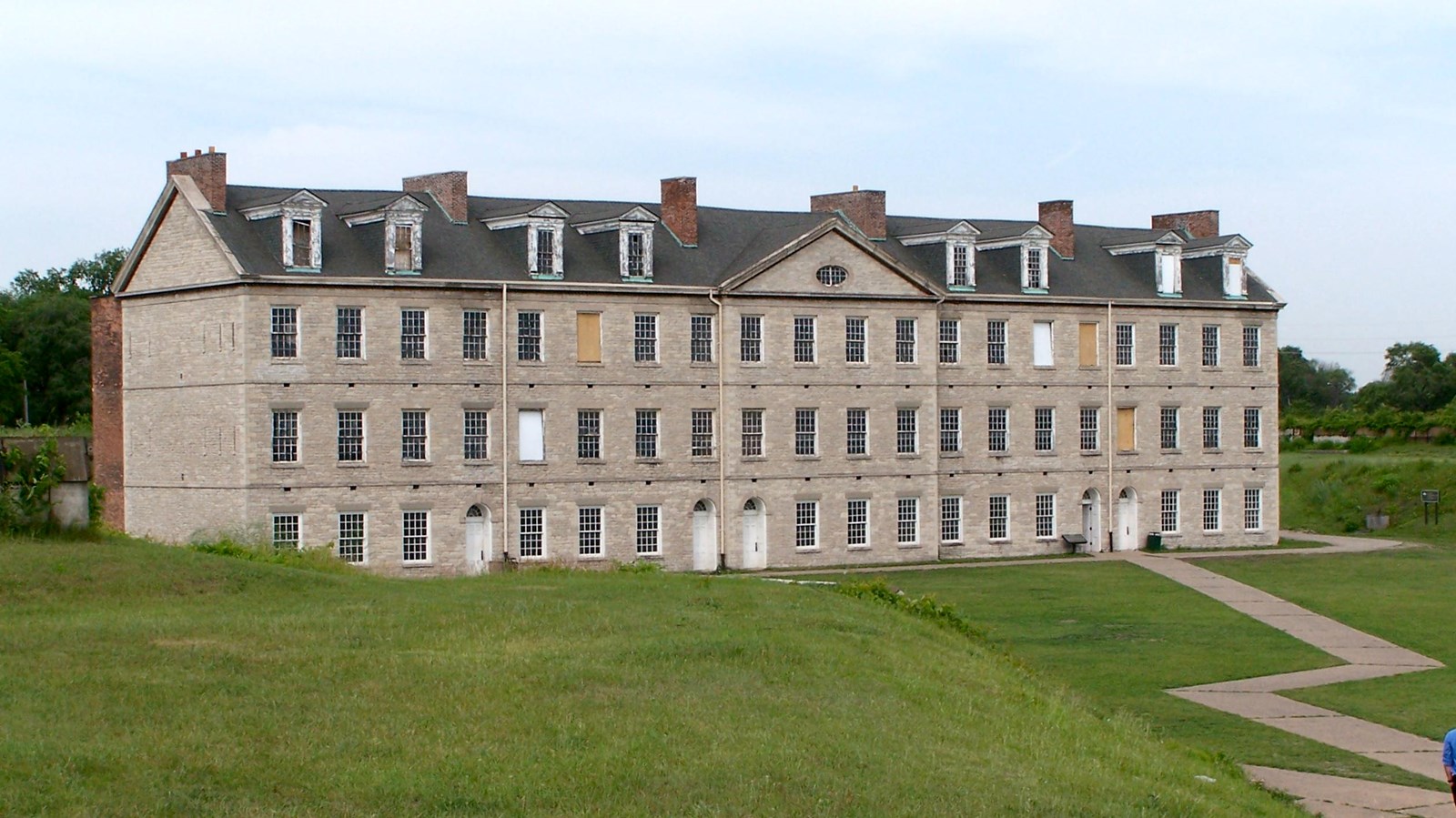Last updated: August 30, 2020
Place
Fort Wayne: Detroit

Ph Taubuch, CC By 2.0, https://commons.wikimedia.org/w/index.php?curid=4891895
Built in 1842, Fort Wayne is perhaps best known for its role in major military conflicts. The fort served as a training camp for Michigan’s volunteer infantry and artillery troops during the Civil War, and a garrison for 500 segregated African American troops in World War I.
During World War II, Detroit became a major supply center for the U.S. military and its allies. Many of the city’s automobile plants were converted for wartime vehicle production. At the Fort Wayne Ordinance Deport, two thousand civilian employees prepared vehicles and parts for shipment overseas. Detroit’s nickname as the “Arsenal of Democracy” reflects these home front production efforts.
Long before the construction of military barracks at the site, large earthworks jutted from the terrain. As early as 1000 CE, people of the Late Woodland culture used the area as burial grounds. Over the centuries, they erected approximately 19 earthwork mounds near the confluence of the Detroit and Rouge Rivers. Looting, erosion, agriculture, and construction eventually destroyed all but one of the mounds.
In 1876, Henry Gillman and the Detroit Scientific Association conducted an excavation of the Fort Wayne mound. Many of the findings were given to the Peabody Museum at Harvard University. In 1944, Carl Holmquist and the Aboriginal Research Club, a group of amateur archaeologists, completed another excavation. They uncovered and removed generations of human burials, specialized pottery dubbed ‘Wayne Ware’, and other burial items including tools and jewelry. Most of these finds are housed at the University of Michigan. Under the Native American Graves Protection and Repatriation Act of 1990, it is illegal to remove human remains and cultural items from Federal and tribal lands without consultation with tribal officials or possible lineal descendants. Although largely reconstructed, the last mound remains on the grounds of Fort Wayne today.
In 1701, French explorer Antoine de la Mothe Cadillac established Fort Pontchartrain du Detroit on the banks of the Detroit River. Motivated by profit, he invited several Native American tribes to settle nearby and participate in the French fur trade. These tribes included the Wyandot, Miami, Ottawa, Ojibwe, and Potawatomi. By 1710, a thriving Potawatomi village occupied the site of present-day Fort Wayne. Referred to as Bellefontaine by the French and Springwells by the British, the site’s sandy bluffs, natural springs, and proximity to the Detroit River offered strategic advantages for settlement, trade, and defense.
In 1760, the British gained control of Detroit as part of the treaty ending the Seven Years’ War. Within twenty years, British Commander Arent DePeyster reported that, for unknown reasons, the Potawatomi sought to transfer their land along the Detroit River and move away. They left Springwells in the care of a Robert Navarre, a former French official in Detroit.
After the American Revolution, the United States gained authority over lands east of the Mississippi River and south of Canada, including Michigan. During the War of 1812, British General Isaac Brock and Shawnee Chief Tecumseh launched an invasion into the U.S. at Springwells. Their coalition included 730 British and 600 Native American soldiers from several allied tribes. Despite promises of neutrality, almost all tribes living in upper Canada and Great Lakes region of the U.S. reportedly participated in the attack. On August 16, 1812, Brock and Tecumseh’s forces crossed the Detroit River to capture Detroit. As a result of their campaign, the British occupied Michigan, including Detroit, for 13 months.
At the end of the war, Springwells became the site of a treaty, ending wartime hostilities between the U.S. government and Native American allies to the British. On September 8, 1815, representatives from the Wyandot, Delaware, Seneca, Shawnee, Miami, Ojibwe, Odawa, and Potawatomi tribes signed the Treaty of Springwells. This treaty brought the tribes under U.S. protection and cleared them of allying with the British. To secure the tribes’ allegiance, the agreement also restored their prewar possessions and rights.
Perhaps recalling Brock and Tecumseh's invasion, the U.S. government decided to build a new fort at Springwells in 1842. Because of its location at the narrowest part of the Detroit River, Springwells was the strategic choice to defend against a British invasion from Canada. Named after Brigadier General Anthony Wayne, Fort Wayne was Detroit’s third fort, but the first built by Americans.
Fort Wayne was listed in the National Register of Historic Places in 1971.
Discover more history and culture by visiting the Detroit travel itinerary.
For more information on Detroit, explore the following websties:
https://www.historicfortwaynecoalition.com/historical_insights.html
https://detroithistorical.org/learn/encyclopedia-of-detroit/fort-wayne
Sources:
Conway, Jim, comp. “10 Key Events of Fort Wayne's Past.” Historic Fort Wayne Coalition. Accessed July 20, 2020.
Conway, Jim, comp. “The Site's Significance to Native Americans.” Historic Fort Wayne Coalition. Accessed July 20, 2020.
Historic Designation Advisory Board. “Final Report, Proposed Fort Wayne Historic District.” Detroit: Detroit City Council, 2016.
Hull, William. Correspondence from William Hull to William Eustis, August 26, 1812. Michigan Pioneer & Historical Collections 40. Clarke Historical Library. Central Michigan University. Mount Pleasant, Michigan.
Newman, Stacy. “Fort Wayne.” Encyclopedia of Detroit. Accessed July 20, 2020.
